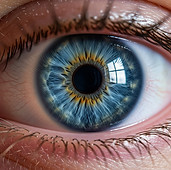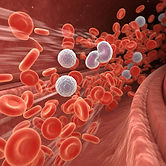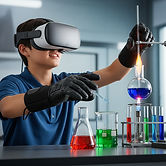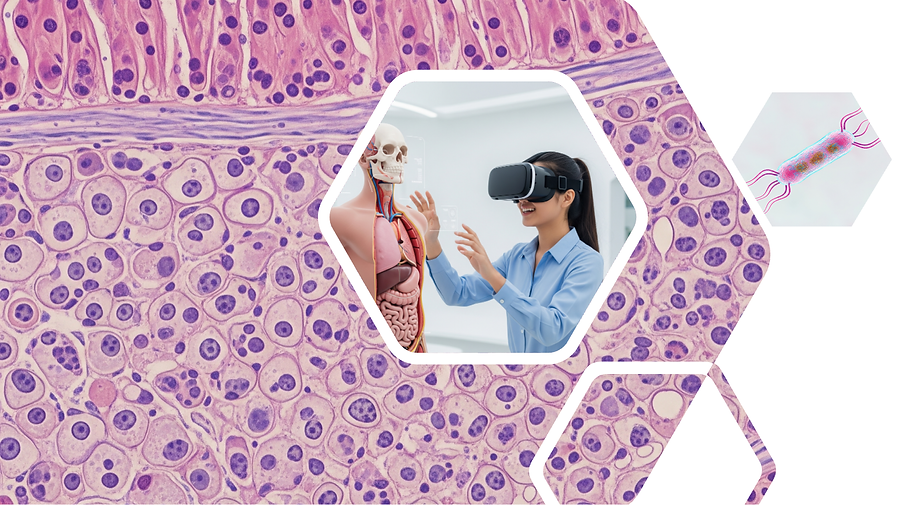Why Learn STEM in VR?
VR Utilizes the Brain’s Fastest Information Channel
VR grabs students’ attention like no other learning tool because it speaks the brain’s native high-speed language — vision. Our eyes send about a gigabit of visual data per second to the brain, thanks to over 100 million receptor cells working in parallel. That’s orders of magnitude more bandwidth than our ears can provide and vastly more than reading text line by line. In VR, this massive visual channel is saturated with lifelike, interactive scenes that place students inside the subject matter. Instead of decoding words or diagrams, they see, explore, and experience concepts as if they were real — making learning faster, more intuitive, and far more memorable.

Gaming-Like Learning in VR Counters AI’s Easy-Answer Trap
VR turns studying into an adventure students want to pursue. In biology VR, they can travel through the bloodstream or explore a coral reef; in the physical and earth sciences, they might launch rockets or track hurricanes. This game-like immersion keeps them curious and engaged — a vital counterbalance in an era where AI delivers instant answers and tempts students to skip the learning process.

3D Spatial Understanding Made Intuitive
Many STEM concepts — from protein structures to tectonic plate movements — are inherently three-dimensional, yet traditional teaching tools flatten them into 2D. In biology VR lessons, students can explore a cell, rotate a DNA helix, or walk around a human skeleton in full 3D. In the physical sciences, they can step inside an atom to see electron orbitals or view electromagnetic fields in space. For earth sciences, they might explore the layers of Earth’s crust or orbit around a 3D model of a hurricane. This immersive approach bridges the gap between abstract theory and real-world visualization.

Learning by Doing in Safe, Controlled Environments
VR biology lets students “enter” a human heart, dissect a virtual frog, or run experiments at the molecular level — all without risk or cost. In the physical sciences, they can safely test high-voltage circuits, adjust gravitational forces, or simulate a rocket launch. In earth sciences, they can model volcanic eruptions, predict storm paths, or manipulate climate variables. These risk-free simulations promote curiosity and fearless experimentation.

Immersive Context That Builds Relevance
Abstract concepts stick when they’re embedded in meaningful, real-world contexts. In VR biology, students might stand inside a bloodstream watching red blood cells flow, while in physics they could witness the curvature of space-time around a black hole. In earth sciences, they might walk through a coral reef ecosystem or explore shifting glaciers over centuries. Context makes learning memorable and sparks long-term interest.

Active Participation
Instead of passively reading or listening, VR biology students manipulate molecules, trace neural pathways, or adjust variables in a virtual ecosystem. Physical science learners might alter magnetic fields and watch their effects, while earth science students could experiment with erosion rates by changing rainfall or vegetation cover. This active role keeps learners engaged and reinforces concepts through doing.

Breaking Time and Scale Barriers
In biology VR, learners can zoom into a protein to observe its atomic structure or speed up cell division to see a complete cycle in seconds. Physical science students can slow down high-speed collisions or fast-forward planetary orbits to watch solar system evolution. In earth sciences, they can rewind thousands of years to watch continental drift or accelerate glacier melting to observe long-term climate effects. Controlling time and scale transforms the impossible into vivid, teachable moments.

Biology VR
Why Biology in Virtual Reality?
Biology can be abstract when limited to textbooks or flat diagrams. VR changes that:
-
Immersive learning – Walk through a beating human heart, zoom into a single cell, or watch mitosis happen right before your eyes.
-
Hands-on exploration – Manipulate 3D models, rotate organs, and examine structures from any angle.
-
Improved understanding – Spatial and interactive learning helps students remember and apply concepts.
Step inside the world of biology like never before. With Biology VR, students can explore the human body, ecosystems, cells, and complex life processes in stunning 3D detail — as if they were really there.

What Students Can Experience in Virtual Reality
Our Biology VR library covers a wide range of topics:
-
Human Anatomy VR – Study the skeletal, muscular, nervous, and circulatory systems in life-like detail.
-
Cell Biology VR – Dive into organelles, DNA replication, and protein synthesis in an interactive microscopic world.
-
Physiology in Action – Watch how the heart pumps, how neurons fire, and how muscles contract — in real time.
Perfect for Classroom & Beyond
-
Aligned with NGSS science standards for middle and high school.
-
Works for in-class demonstrations, lab supplements, and self-guided learning.
-
Ideal for biology teachers, homeschooling families, and STEM enrichment programs.
Why Choose Our Biology VR Programs?
-
High-quality 3D models created with input from biology educators.
-
Affordable shared-access model: no need for every student to own VR equipment & simulations.
-
Guided lessons and activities developed by science instructors.
See It in Action
-
🎥 Watch our demo video: Biology VR in the Classroom
-
📅 Book a free trial session for your school.